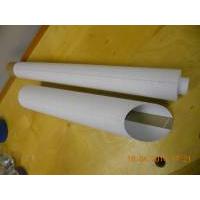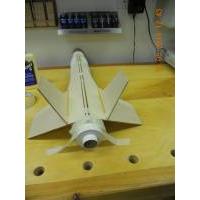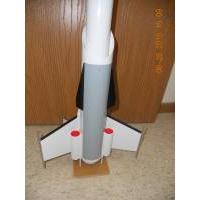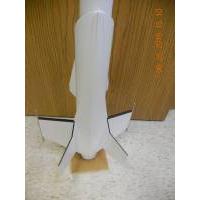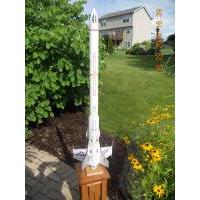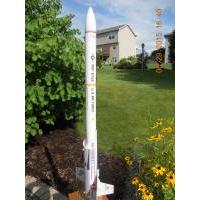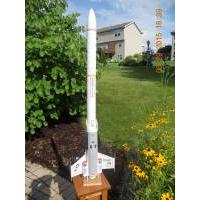| Construction Rating: | starstarstarstarstar_border |
| Flight Rating: | starstarstarstarstar_border |
| Overall Rating: | starstarstarstarstar_border |
| Published: | 2015-07-04 |
| Manufacturer: | Sirius Rocketry  |
 Brief
Brief
The Sirius Rocketry Interrogator G (Kit Number S-0015) is a Transition Series mid/high power rocket kit. It is described as a Near-Space Fighter, which accurately denotes both its militaristic and futuristic/fantasy detailing. The finished rocket is 44.125" in length. The main body tube is 2.245" in diameter, but the aft intake shroud is 3.0" tubing, cut at a bias on the front end. The large main wings are canted and have perpendicular rudders, and there are two strakes on the forward end of the intake tube, and a Ramjet tube tucked under each wing. The rocket has a 29-mm motor mount and can fly on F, G, and small H motors, and is equipped with a 30" rip-stop nylon parachute for recovery. The kit includes both a 1/4" launch lug and two rail buttons for a 1010-style rail, and four full-color water-slide decal sheets to provide incredible detail to the finished rocket.
Components
The parts list for this rocket is as follows:
- Rail Button Kit (hardware for two rail buttons for 1010-style rail)
- Motor retention hardware kit
- 1/8" Laser-cut plywood sheet for wings, rudders, strakes, and centering rings
- 3.0"-Diameter Intake Tube (16.5" long)
- Detailed instruction manual, loaded with helpful diagrams
- 1/4" x 2.4" Launch Lug
- Balsa Nose Cone
- Nose cone Dowel Insert and Screw Eye
- T52-H Ramjet Tubes (4-1/16" long) (2)
- Main Body Tubes T70-H (19.5" long) (2)
- T70-4 Coupler Tube (4" long)
- 30"-Diameter Ripstop Nylon Parachute Kit
- T52-H 29mm Motor Mount Tube (18-1/16" long)
- 1/4"-Diameter Conduit Dowel (16.5" long)
- 1/8" Quick Link
- Kevlar Shock Cord Mount Cord (36" long)
- 1/2"-Wide Elastic Shock Cord (6' long)
- 3/16"-Diameter Detail Dowels (5-3/4" long ) (4)
- Marking guide Sheet P/N S-1015-MG
- Four Decal Sheets (P/N D-1015-1, -2, -3, and -4)
Construction
I built the kit per the detailed instructions, which provide plenty of information on building a rocket that withstand the rigors of high powered motors. I chose to attach the centering rings to the motor mount with 20-min epoxy, but I used Elmer's Tightbond II glue for all other assembly. I filled the tube spirals on the exterior of the main body tubes, and on both the exterior and interiors of the ramjet tubes and the large intake tube near the tube ends to provide a good esthetic in the finished rocket. The laser-cut parts fit together very well, and the plywood needed very little sanding. I chose to leave the plywood edges unrounded per the instructions. Before gluing the main body tube inside the intake tube, i masked off the areas that would form the glue joint and primed the exterior of the main body tube and the interior of the intake tube using KILZ white primer (fig. 1).

These surfaces were sanded smooth and reprimed and sanded before assembly to ensure there would be no paint shadows inside the intake tube when the model was finished. Once these tubes are glued together the hardwood dowel is carefully aligned and glued at the top of the body tubes (fig 2).

The only two other tricky parts to the assembly were to 1) ensure a large flat surface for gluing the wings to the intake tube and careful alignment of the body tubes to the table: this sets the wing dihedral angle (fig 3), which you want equal on both sides of the rocket; and 2) be very fast when gluing the two main tubes together with the coupler: this glue joint will seize up very easily as the components have very tight tolerances.

Finishing
The instructions provided detailed information on finishing the model: paint schemes, decal placement, and tips to achieve a good paint finish. As mentioned above some partial finishing was needed during assembly on the interior of the intake tube. The entire model was painted with white Rustoleum paint/primer. Other colors (gray underbelly of the intake tube,orange-red interior of the ramjets, black wing edges, and silver wing tip dowels) were then applied to the model (figs 4 and 5).


Finally the decals were carefully applied and the entire rocket sprayed with several coats of Rustoleum Clear Matte (figs 6,7,and 8). I added a vinyl CG sticker (fig 8) to remind myself to ensure that CG is ahead of this location when the rocket is fully prepped and ready for flight (location provided by Sirius Rocketry).



Flight
I've flown this rocket most often on Aerotech F52-5T motors, but have also successfully flown on an Aerotech G71R-7 and a CTI G106-9 Skidmark. The rocket has always boosted arrow straight with no rotation and does wind-cock a bit as it is typically overstable with the F motors. The motors recommended by Sirius Rocketry are F52-5T, F60-4R, F50-6T, G40-7W, G80-7R, G80-7T, H128W-M, and H180W-M. Because G motors nearly put this rocket out of sight, I've been too nervous to try an H motor because I did not want to lose this rocket--too many hours finishing to lose it sight-unseen.
Recovery
The ripstop nylon parachute is well-sized for the rocket and I've never had any major recovery damage when the parachute fully deployed. I added a 5"-square of Aramid as a chute protector and this has worked very well. The long stuffer tube ensures that the motor ejection charge deploys the parachute with gusto.
Summary
This is the second Sirius Rocketry Kit I've had the pleasure of building and flying. The materials of construction are all excellent, and the use of heavy-walled tubes, while adding some weight, allow this rocket to be flown with large motors without fear of tube collapse upon a less than optimal recovery. David Miller of Sirius Rocketry has produced an extremely handsome rocket that, if built and decorated per his instructions, will be the pride of your mid power fleet.
 |
 |
Flights
Sponsored Ads
 |
 |
